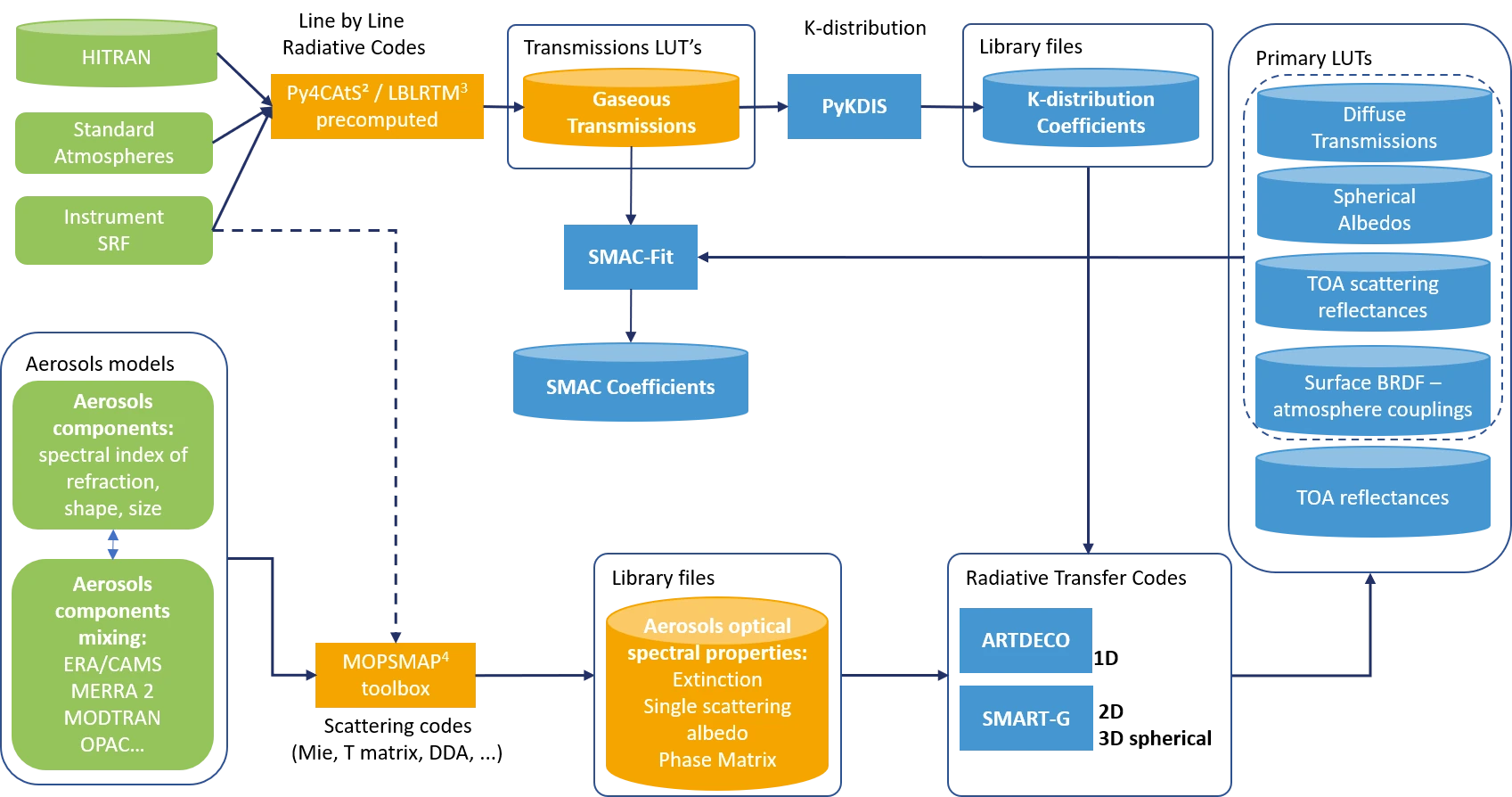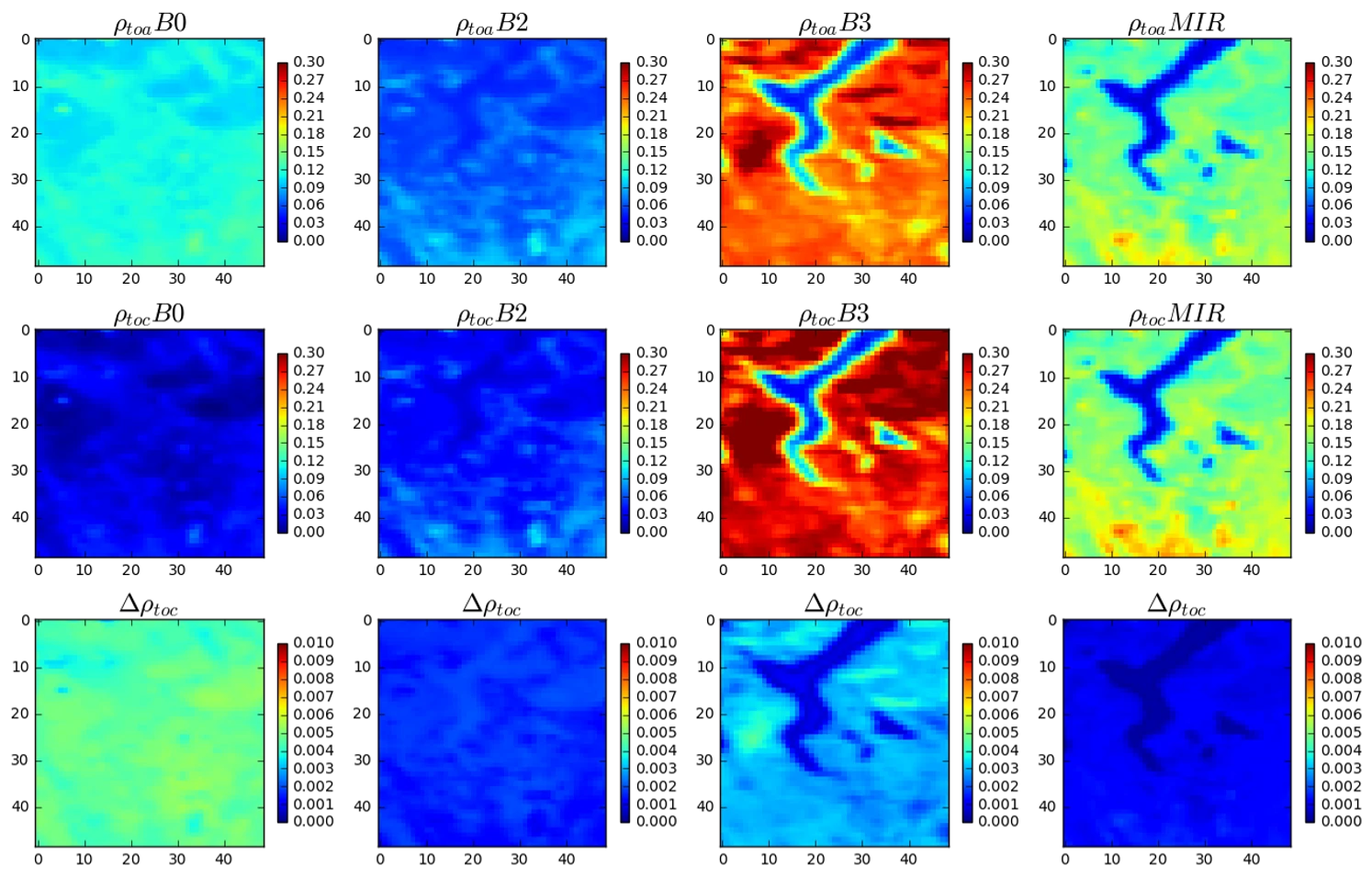
SMAC-CL / SMAC-COEFF
The Simplified Model of Atmospheric Correction (SMAC) allows the analytical calculation of the Top-Of-Atmosphere (TOA) reflectance depending on the gazes and atmospheric aerosols, on the surface pressure and on the surface reflectivity. Sensor specific coefficients of each equation are determined using a best fit technique against the computations of an exact radiative transfer code. Thus, SMAC can be easily inverted to retrieve the surface reflectance when the TOA reflectance is known. As it is computationally fast, it is particularly useful for performing atmospheric correction in near real time on huge amount of satellite sensor data.
Steadily improving tools
HYGEOS has entirely refactored and significantly upgraded the original SMAC1 code, developed by LERTS, now CESBIO, in 1990’s, keeping only the concept of semi-empirical formulations describing the different interactions (absorption, scattering, transmission, etc.) of solar radiation with atmospheric components along its path through the atmosphere. Now, the SMAC-CL code implements in OPEN-CL the original SMAC algorithm but with additionnal aerosol models, BRDF effects, etc.
In particular, HYGEOS also developed the SMAC-COEFF module which allows to calculate the SMAC coefficients for any sensor, knowing its spectral response function and other basic data. Aerosols optical and spectral properties and gaseous transmission are calculated separately to achieve completely absorption/scattering coupling as described in the figure below. Look-Up-Tables (LUTs) are thus calculated using the ARTDECO radiative transfer model, jointly developed by the Laboratoire d’Optique Atmosphérique and HYGEOS, or using SMART-G. Finally, these LUTs are fitted to generate SMAC coefficients. HYGEOS has computed SMAC coefficients for a number of sensors including PROBA-V, Sentinel-3/OLCI & SLSTR, MODIS, VIIRS, the successive AVHRR/NOAA sensors for application in the operational processing chains of the Copernicus Climate Change and Global Land Services and for land monitoring research projects.

Architecture of SMAC-COEFF tool. The modules in blue boxes were developed totally or partly by HYGEOS.

Example of SMAC-CL application: TOC reflectances (middle) and their corresponding uncertainties (bottom) as retrieved by SMAC-CL from the TOA reflectance (top) for each SPOT/VEGETATION spectral band; 49×49 pixels around AERONET station of Ispra on 1st of June 1999.
HYGEOS continues to upgrade SMAC-CL implementing new functionalities. Thus, the Jacobians has been added in order to calculate and propagate the uncertainties due to the key model parameters like the aerosol optical depth or the column of water vapor. The uncertainty due to the aerosol model is also taken into account. Further in-depth improvements are ongoing.
Contact at HYGEOS: Didier Ramon
(1) Rahman H. and G. Dedieu, “SMAC: a simplified method for the atmospheric correction of satellite measurements in the solar spectrum”. Intern. J. Remote Sens., 15, 123-143, 1994. https://doi.org/10.1080/01431169408954055
(2) Schreier, F. and S. Gimeno Garcia, “Py4CAtS – Python Tools for Line-by-Line Modelling of Atmospheric Radiative Transfer”. In Robert F. Cahalan and Jürgen Fischer (editors), Radiation Processes in the Atmosphere and Ocean (IRS 2012): Proceedings of the International Radiation Symposium (IRC/IAMAS) Volume 1531 of AIP Conference Proceedings, pages 123 – 126. American Institute of Physics, 2013. https://doi.org/10.1063/1.4804723. https://atmos.eoc.dlr.de/tools/Py4CAtS
(3) Hogan, R. J. and M. Matricardi, “Evaluating and improving the treatment of gases in radiation schemes: the Correlated K-Distribution Model Intercomparison Project (CKDMIP)”, Geosci. Model Dev., 13, 6501–6521, 2020. https://doi.org/10.5194/gmd-13-6501-2020
(4) Gasteiger, J. and M. Wiegner, “MOPSMAP v1.0: a versatile tool for the modeling of aerosol optical properties“. Geosci. Model Dev., 11, 2739–2762, 2018. https://doi.org/10.5194/gmd-11-2739-2018

